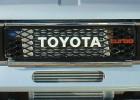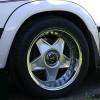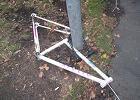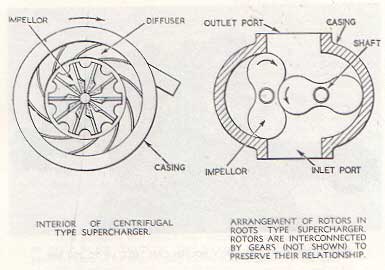| Author | Topic |
|---|

Toymods Club Treasurer
Location:
Sydney
Registered:
May 2002
|
|
|

Location:
Perth
Registered:
October 2003
|
|
Re: Toyota SC14 Supercharger pros/cons on small diesel
|
 Mon, 01 November 2004 04:33
Mon, 01 November 2004 04:33
 
|
 |
|
I think it would be a whole lot of heartache for little if any gain, you could easily destroy the performance as much as you could improve it. But if you like a challenge go for it.
|
|
|

Location:
c'town, NSW
Registered:
May 2002
|
|
Re: Toyota SC14 Supercharger pros/cons on small diesel
|
 Mon, 01 November 2004 04:42
Mon, 01 November 2004 04:42
 
|
 |
considered another turbo built up that will suit your needs?
rather than going thru the fuss of getting a SC in there.
|
|
|
Location:
Brisbane
Registered:
February 2003
|
|
Re: Toyota SC14 Supercharger pros/cons on small diesel
|
 Mon, 01 November 2004 04:59
Mon, 01 November 2004 04:59
 
|
 |
i'd be comparing the air flow from the turbo and choosing an appropriate SC or turbo based on that.
AFAIK, diesel requires much more air than similar capacity petrol engine. You might might that the SC14 quickly dies (from 100% duty), or simply runs out of puff before you get out of torque band.
a vortech or an eaton might be more what you're after?
|
|
|

Location:
Brisbane
Registered:
May 2002
|
|
Re: Toyota SC14 Supercharger pros/cons on small diesel
|
 Mon, 01 November 2004 05:34
Mon, 01 November 2004 05:34
 
|
 |
A piston engine is a positive-displacement pump... I can't see how a diesel engine is going to displace any more air than a petrol engine of the same size at the same RPM, unless the diesel has significantly higher VE? (Unlikely methinks).
|
|
|

Location:
Kita-Ku, Sapporo, Japan
Registered:
January 2003
|
|
Re: Toyota SC14 Supercharger pros/cons on small diesel
|
 Mon, 01 November 2004 06:26
Mon, 01 November 2004 06:26
 
|
 |
agreed Norbie,
but a diesel is effectively at WOT (with respect to air) all the time.. it' the fuel that throttles (do i have that right?)
the SC14 does the job on a 2L petrol motor.. it displaces 1.4L.
to provide 2L of air, it needs to be overspun 43%.
to provide 12psi, say you need to push about 1 bar with SC.. ie 4L/1.4 = SC speed = 2.86 times that of motor.
SC14 has top speed of what? 14000rpm??
14000/2.86 = 4900rpm.
sounds, on paper, to be just perfect  the problem with overspinning the SC on a 1G is that they run out of revs or blower spins too fast.. the problem with overspinning the SC on a 1G is that they run out of revs or blower spins too fast..
with the diesel, you will only just overspin by redline (although you could gear back a little, sayy 2.7 x motor speed)
you will however, increae parasitic drag on the motor, but since you are not going to high revs anyway, this won't be that much of an issue...
what you will get is maximum torque from near idle 
Cya, Stewart
|
|
|
Location:
Brisbane
Registered:
February 2003
|
|
Re: Toyota SC14 Supercharger pros/cons on small diesel
|
 Mon, 01 November 2004 08:25
Mon, 01 November 2004 08:25
 
|
 |
you'd also be looking at tinkering with the fueling to get the power output up - no point in ramming in more air, if there's not enough fuel.
regarding volume of air needed, i'm guilty of having very little knowledge of the subject. sorry 'bout that. I just figured that with an already high compression ratio, you'ld need to shove in a lot more air and fuel to make a decent improvement in performance? a wild guess. 
also, is the 1G-GZE setup like the 4AGZE with the bypass valve? how would you plumb that in given that there is no TB? or if it's running 100% duty, how long would it last?
and don't truck turbo tend to have very different characteristics from their hi-revving petrol siblings? significant gas flow from the exhaust, but limited rev range?
|
|
|

Location:
Montrose, VIC
Registered:
May 2002
|
|
Re: Toyota SC14 Supercharger pros/cons on small diesel
|
 Mon, 01 November 2004 08:48
Mon, 01 November 2004 08:48
 
|
 |
I'd be tempted to actually give it a go. I think that you want to make sure that you're using a decent flowing inlet manifold (the stocker looks a bit nasty..), a decent exhaust, and then you might need to start looking at the cam etc. a bit. After that, you'd definately need to start playing some games with the fuelling side of things. However, because the blower's airflow is related straight to RPM and (being no throttle) nothing else, whereas the turbo will spool up depending on engine load/fuelling, you'll find either one of two things:
1. You'll get fantastic fuel economy, because the blower is a more efficient air pump than the engine itself, and is essentially 'doing some of the work' of the engine all of the time, therefore decreasing pumping losses, as the blower is not throttled back like a spark ignition engine. You'll also find that you're keeping fantastic exhaust valve temperatures. The constant extra airflow will keep the combustion cooler, thereby allowing extra fuel to be added before the critical temperatures are reached, making more power when you want it. Also the loss of the restriction of the very tiny factory turbo will help greatly.
2. The thing will turn into a black smoking pig!
I'm leaning towards number 1 myself, and I'd be very interested to see how it goes if you do try it.
|
|
|

Location:
cambo
Registered:
May 2002
|
|
Re: Toyota SC14 Supercharger pros/cons on small diesel
|
 Mon, 01 November 2004 10:23
Mon, 01 November 2004 10:23
 
|
 |
|
my advice: dont fuck with diesels. the injector pumps are a PITA to get right. i havent seen your motor, but i assume its a distributor type pump. an even bigger pain than an inline pump.
|
|
|

Toymods Club Treasurer
Location:
Sydney
Registered:
May 2002
|
|
Re: Toyota SC14 Supercharger pros/cons on small diesel
|
 Tue, 02 November 2004 02:41
Tue, 02 November 2004 02:41
 
|
 |
I'll try to supply some more info about my engine.
Has a compression ratio of 24:1
Does not blow any black smoke. I run 20mL of injector cleaner with every refuel & this is evident by the lack of black residue on the back of my car (help when installed a dump pipe on the end of the exhaust instead of straight out)
Yes, it runs a mechanical injector pump which has a crude manual adjustment for fuel, but also has a computer attached to control the advance & amount of fuel relative to the boost level.
The turbo itself is not a problem. I don't know what turbo it is but it looks like the size of a CT20. It will however have different vane angles, etc.
The biggest problem is the exhaust manifold.
My engine is mounted east-west.
Due to the size of the injector pump, it ,and the inlet manifold, is mounted on the front of the motor with the p/s pump above & A/C comp below.
The turbo is a high mount on the back of the motor near the left end cylinder.
Underneath the exhaust manifold & above the steering rack, the the oil filter (100mm dia, 150mm long) is mounted horizontally.
The exhaust manifold itself is a log type with one side about 50mm away from the head. Therefore, no nice curves or merges. Just sharp right angles and T joints. And because of all the other things around it, a nice equal length smooth bended jobbie simply won't fit.
The inlet manifold is log type as well, with no throttle body & a turn around the left end of the head to aim at the turbo outlet.
I'm already running a 2.5" straight through exhaust, so that won't be an issue.
Yes, fuel delivery will have to be tinkered with, but as the engine is already designed to pump in more fuel (to a point) with more boost, this will only be a crude adjustment.
The main aim of the exercise is to have boost earlier to overcome the lag problem. I'm not interested in what happens past 4000rpm. If you've seen my torque curve, you'd see why.
Exhaust temp is a critical part of tuning a diesel. This is an indication of how hot the combustion is (too hot & the fuel ignites too early)
I'm already starting to look at how to fit a water-air intercooler in, plus engine oil cooler to help keep combustion temp down.
|
|
|

Location:
Perth
Registered:
October 2003
|
|
Re: Toyota SC14 Supercharger pros/cons on small diesel
|
 Tue, 02 November 2004 04:45
Tue, 02 November 2004 04:45
 
|
 |
Steve, I thought you said your engine was common rail?
More than likely you didnt though 
|
|
|

Toymods Club Treasurer
Location:
Sydney
Registered:
May 2002
|
|
Re: Toyota SC14 Supercharger pros/cons on small diesel
|
 Tue, 02 November 2004 04:49
Tue, 02 November 2004 04:49
 
|
 |
No, the next model had common rail.
I'll get a pic of my engine bay & post it up tomorrow.
|
|
|

Location:
Perth
Registered:
October 2003
|
|
|

Location:
cambo
Registered:
May 2002
|
|
Re: Toyota SC14 Supercharger pros/cons on small diesel
|
 Tue, 02 November 2004 06:09
Tue, 02 November 2004 06:09
 
|
 |
exactly. the accelerator pump acts on the govenor which alters the amount of fuel to determine engine speed. for a $0 power increase you can alter the govenor stop screw for more power. but as skip said, its heat that kills diesels. if your determined to get more power out of your diesel, the first thing you want to do is get a nice big oil cooler.
so what pump do you have, distributor or inline?
|
|
|

Toymods Club Treasurer
Location:
Sydney
Registered:
May 2002
|
|
Re: Toyota SC14 Supercharger pros/cons on small diesel
|
 Wed, 03 November 2004 00:39
Wed, 03 November 2004 00:39
 
|
 |
Distributor.
And as Skip quoted me, I know that heat is the killer.
I'm in the process of getting a temp guage to attach to the exhaust for this reason.
How does the supercharger's boost respond relative to it revs?
|
|
|

Location:
Kita-Ku, Sapporo, Japan
Registered:
January 2003
|
|
Re: Toyota SC14 Supercharger pros/cons on small diesel
|
 Wed, 03 November 2004 00:58
Wed, 03 November 2004 00:58
 
|
 |
| wagonist wrote on Wed, 03 November 2004 11:39 |
How does the supercharger's boost respond relative to it revs?
|
linear.
as it is a positive displacement pump, it will output 1.4L of room pressure air per revolution. this will become less volume as it's pressurised, and the higher the output pressure, the greater the temp rise at the outlet.
with an SC, you should get near max boost from idle upwards.. ther eis no lag. the only thign is that at low rpm, the cam profiles may be such that some of the intake charge is blown out the exhaust due to valve overlap.
if you think you can put in more fuel (or the motor already puts in enough fuel at these lower rpm) then using an SC will make boost much much earlier than the turbo...
onl;y problem i see is that your fuel economy will suffer.... particularly if the SC is pumping all the time, and that much air is not needed.. you could experiment with throttling the intake of the SC, such that on highway/cruise, you are not forcibly pumping so much air.. the turbo, running off "free" exhaust power, would usually increase highway economy...
a water to air IC will make a big difference to intake temps and is probably recommended...
i reckon just give it a go.. would be pretty cheap to set up, and you don't have to worry about AFR like the rest of us... at worst, if the pump doesn't supply thr fuel down low, you will just have a bit more parasitic drag from pumping air, but as soon as the fuel is available, the power will be made... will make an already torquey motor just that much more "stout"
Cya, Stewart
|
|
|

Toymods Club Treasurer
Location:
Sydney
Registered:
May 2002
|
|
Re: Toyota SC14 Supercharger pros/cons on small diesel
|
 Wed, 03 November 2004 01:13
Wed, 03 November 2004 01:13
 
|
 |
Sorry, I don't quite get that.
If the boost reponds linearly to the SC revs (which is relative to the engine revs) then you're going to have max boost at max engine revs.
How do you get max boost at near idle then?
Is it is function of the supercharger design?
or does it vent the excess pressure after a point?
Not particularly worried about the fuel economy (I get about 700km/60L around town & I've done Sydney to Brisbane, 890km, on 58L)
Plus my car is strictly an after hours car as I bring home a work vehicle.
|
|
|

Location:
Kita-Ku, Sapporo, Japan
Registered:
January 2003
|
|
Re: Toyota SC14 Supercharger pros/cons on small diesel
|
 Wed, 03 November 2004 01:29
Wed, 03 November 2004 01:29
 
|
 |
| wagonist wrote on Wed, 03 November 2004 12:13 |
Sorry, I don't quite get that.
If the boost reponds linearly to the SC revs (which is relative to the engine revs) then you're going to have max boost at max engine revs.
How do you get max boost at near idle then?
Is it is function of the supercharger design?
or does it vent the excess pressure after a point?
|
well...
it is a positive displacement pump. it is a function of the SC's design...
that means that for each revolution, a certain amount of air is moved, regardless of rpm. look at the pics below... the air actually moves around the OUTSIDE of the casing, and the inside part where the lobes mesh SEALS the center of the SC...
unlike a turbo, at idle rpm, the SC will move 1.4L of air per SCrevolution. at high rpm, the SC will move 1.4L of air per SCrevolution. the boost is then just a result of how much air doesn't get into the engine! or more simply, if the engine capacity is less than the SC's capacity x the drive ratio, then there will be intake pressure.


a turbo on the other hand requires exhaust energy to get the turbine and thus compressor spinning.. you have to wait until there is enough exhaust to move enough intake charge, to make enough exhaust to make enough intake charge to make boost 
the downside of an SC is that the losses increase by the square of rpm, ie the power required to drive it increases with rpm. the heat generated will also increase with rpm...
if you are driving the SC at 'normal' SC speeds, then the losses will not be huge (maybe 10hp? at most).
an SC is less efficient at compressing air (i think) since the compression only happens when the room pressure air contained by the lobes, hits the already pressurised air in the intake... causing heat to be generated..
twisted lobe SC's like:

have less of a pressure pulsation, and thus less heat generated, and are more efficient...
so anyway, the amount of air moved by the SC is linear with rpm. if the amount of air consumed by the engine is linear with rpm, then the resulting boost will also be linear. there will be fluctations due to engine efficiency and cam profiles, but compared to a turbo? linear boost with RPM..
|
|
|

Location:
Perth
Registered:
October 2003
|
|
Re: Toyota SC14 Supercharger pros/cons on small diesel
|
 Wed, 03 November 2004 01:43
Wed, 03 November 2004 01:43
 
|
 |
| Quote: |
onl;y problem i see is that your fuel economy will suffer.... particularly if the SC is pumping all the time, and that much air is not needed.. you could experiment with throttling the intake of the SC, such that on highway/cruise, you are not forcibly pumping so much air.. the turbo, running off "free" exhaust power, would usually increase highway economy...
|
My Navara has a butterfly between the turbo outlet and intake manifold. It remains closed (not completely) then when the engine comes on boost it completely opens. These are the only two modes it has opened or closed. Was quite funny watching it on the dyno. Anyways what exactly would the purpose of this butterfly be?
|
|
|

Toymods Club Treasurer
Location:
Sydney
Registered:
May 2002
|
|
Re: Toyota SC14 Supercharger pros/cons on small diesel
|
 Wed, 03 November 2004 02:13
Wed, 03 November 2004 02:13
 
|
 |
Thanks.
Very nice explanation.
a 10hp loss on my car over the existing would be noticable.
Best figure I've got on a dyno is 49.5kW at the wheels.
as I've described earlier, I think the biggest problem with the lag is caused by the exhaust manifold restricting flow.
|
|
|

Location:
cambo
Registered:
May 2002
|
|
Re: Toyota SC14 Supercharger pros/cons on small diesel
|
 Wed, 03 November 2004 10:16
Wed, 03 November 2004 10:16
 
|
 |
|
Skip, if you have a closer look you will notice a venturi with the butterfly, just like a carby. this is to provide a vacuum for the govenor and whatever. its just there cause a diesel inlet manifold has no vacuum, thats why it needs a vacuum pump on the back of the altenator.
|
|
|
Location:
wangaratta
Registered:
May 2004
|
|
Re: Toyota SC14 Supercharger pros/cons on small diesel
|
 Wed, 03 November 2004 11:12
Wed, 03 November 2004 11:12
 
|
 |
wagonist:
although a SC may cost you 10 HP to run, a turbo has power losses that come with it too, its just that they are harder to measure.
a crappy manifold design, and the turbine and housing restricting exhaust flow restrict power in a turbo engine.
just something to consider. . .
|
|
|

Location:
Kita-Ku, Sapporo, Japan
Registered:
January 2003
|
|
Re: Toyota SC14 Supercharger pros/cons on small diesel
|
 Wed, 03 November 2004 14:03
Wed, 03 November 2004 14:03
 
|
 |
ahh, good point  turbo has backpressure as well as the crappy manifolds... turbo has backpressure as well as the crappy manifolds...
the SC may not be 10hp tho... there must be some data around... failing that you could use Eaton M90 data as a maximum..
|
|
|

Toymods Club Treasurer
Location:
Sydney
Registered:
May 2002
|
|
Re: Toyota SC14 Supercharger pros/cons on small diesel
|
 Wed, 03 November 2004 22:27
Wed, 03 November 2004 22:27

|
 |
The turbine housings are generally smaller on a diesel compared to a similar petrol engine.
Is it true that exhaust gas speed is higher in a diesel?
I imagine that 24:1 compression ratio compared to 10:1 would try to "squeeze" the gas out faster.
Would that be the reason why I can get 12psi at only around 2000rpm?
|
|
|